LvYY1 Activates WSSV ie1 Promoter for Enhanced Vaccine Production and Efficacy
Abstract
1. Introduction
2. Materials and Methods
2.1. Viruses and Cells
2.2. Construction of Baculoviral Expression Vectors Containing LvYY1
2.3. Generation and Titration of Recombinant Baculovirus
2.4. Immunofluorescence Assay (IFA)
2.5. Western Blot
2.6. Flow Cytometry
2.7. Gel Shift Assays
2.8. Hemagglutination Assays
2.9. Transduction and Quantitative PCR (qPCR)
2.10. Animal Study
2.11. Serological Assays
2.12. Hemagglutination Inhibition (HI)
2.13. Statistical Analysis
2.14. Ethical Approval and Informed Consent
3. Results
3.1. LvYY1 Expression and Interaction with WSSV ie1 Promoter in Baculovirus
3.2. LvYY1 Enhanced eGFP Expression Driven by WSSV ie1 Promoter
3.3. LvYY1 Improved CSFV E2 Secretion under WSSV ie1 Promoter in Sf-9 Cells
3.4. LvYY1 Stimulated Active and Functional H5 Hemagglutinin Expression in Baculovirus
3.5. LvYY1-ie1 Baculovirus Mediated H5 Transduction in CEF Cells
3.6. LvYY1-ie1 Baculovirus Presented Improved Protective Immunogenicity in Chicken against H5 AIVs
4. Discussion
5. Conclusions
Supplementary Materials
Author Contributions
Funding
Acknowledgments
Conflicts of Interest
References
- Kost, T.A.; Kemp, C.W. Fundamentals of baculovirus expression and applications. Adv. Exp. Med. Biol. 2016, 896, 187–197. [Google Scholar] [PubMed]
- Madhan, S.; Prabakaran, M.; Kwang, J. Baculovirus as vaccine vectors. Curr Gene 2010, 10, 201–213. [Google Scholar] [CrossRef] [PubMed]
- Ji, W.; Guo, Z.; Ding, N.Z.; He, C.Q. Studying classical swine fever virus: Making the best of a bad virus. Virus Res. 2015, 197, 35–47. [Google Scholar] [CrossRef] [PubMed]
- Blome, S.; Staubach, C.; Henke, J.; Carlson, J.; Beer, M. Classical swine fever—An updated review. Viruses 2017, 9, 86. [Google Scholar] [CrossRef]
- Xu, H.; Wang, Y.; Han, G.; Fang, W.; He, F. Identification of E2 with improved secretion and immunogenicity against CSFV in piglets. BMC Microbiol. 2020, 20, 26. [Google Scholar] [CrossRef]
- Zhang, H.; Wen, W.; Zhao, Z.; Wang, J.; Chen, H.; Qian, P.; Li, X. Enhanced protective immunity to CSFV E2 subunit vaccine by using IFN-γ as immunoadjuvant in weaning piglets. Vaccine 2018, 36, 7353–7360. [Google Scholar] [CrossRef]
- Muñoz-González, S.; Sordo, Y.; Pérez-Simó, M.; Suarez, M.; Canturri, A.; Rodriguez, M.P.; Frías-Lepoureau, M.T.; Domingo, M.; Estrada, M.P.; Ganges, L. Corrigendum to “Efficacy of E2 glycoprotein fused to porcine CD154 as a novel chimeric subunit vaccine to prevent classical swine fever virus vertical transmission in pregnant sows”. Vet. Microbiol. 2018, 213, 143–149. [Google Scholar] [CrossRef]
- Ganges, L.; Núñez, J.I.; Sobrino, F.; Borrego, B.; Fernández-Borges, N.; Frías-Lepoureau, M.T.; Rodríguez, F. Recent advances in the development of recombinant vaccines against classical swine fever virus: Cellular responses also play a role in protection. Vet. J. 2008, 177, 169–177. [Google Scholar] [CrossRef]
- Beer, M.; Reimann, I.; Hoffmann, B.; Depner, K. Novel marker vaccines against classical swine fever. Vaccine 2007, 25, 5665–5670. [Google Scholar] [CrossRef]
- Duan, L.; Bahl, J.; Smith, G.J.; Wang, J.; Vijaykrishna, D.; Zhang, L.J.; Zhang, J.X.; Li, K.S.; Fan, X.H.; Cheung, C.L.; et al. The development and genetic diversity of H5N1 influenza virus in China, 1996–2006. Virology 2008, 380, 243–254. [Google Scholar] [CrossRef]
- Webster, R.G.; Govorkova, E.A. H5N1 influenza—Continuing evolution and spread. N. Engl. J. Med. 2006, 355, 2174–2177. [Google Scholar] [CrossRef]
- Alexander, D.J. An overview of the epidemiology of avian influenza. Vaccine 2007, 25, 5637–5644. [Google Scholar] [CrossRef] [PubMed]
- He, F.; Madhan, S.; Kwang, J. Baculovirus vector as a delivery vehicle for influenza vaccines. Expert Rev. Vaccines 2009, 8, 455–467. [Google Scholar] [CrossRef] [PubMed]
- Prabakaran, M.; Madhan, S.; Prabhu, N.; Qiang, J.; Kwang, J. Gastrointestinal delivery of baculovirus displaying influenza virus hemagglutinin protects mice against heterologous H5N1 infection. J. Virol. 2010, 84, 3201–3209. [Google Scholar] [CrossRef] [PubMed]
- Mansouri, M.; Berger, P. Baculovirus for gene delivery to mammalian cells: Past, present and future. Plasmid 2018, 98, 1–7. [Google Scholar] [CrossRef] [PubMed]
- Miller, L.K. Baculoviruses as gene expression vectors. Annu. Rev. Microbiol. 1988, 42, 177–199. [Google Scholar] [CrossRef]
- Fath-Goodin, A.; Kroemer, J.; Martin, S.; Reeves, K.; Webb, B.A. Polydnavirus genes that enhance the baculovirus expression vector system. Adv. Virus Res. 2006, 68, 75–90. [Google Scholar]
- Mitchell-Logean, C.; Murhammer, D.W. bcl-2 expression in Spodoptera Frugiperda Sf-9 and Trichoplusia Ni BTI-Tn-5B1-4 insect cells: Effect on recombinant protein expression and cell viability. Biotechnol. Bioeng. 1997, 56, 380–390. [Google Scholar] [CrossRef]
- Lin, G.; Li, G.; Granados, R.R.; Blissard, G.W. Stable cell lines expressing baculovirus P35: Resistance to apoptosis and nutrient stress, and increased glycoprotein secretion. Vitr. Cell Dev. Biol. Anim. 2001, 37, 293–302. [Google Scholar] [CrossRef]
- Ma, G.; Yu, L.; Wang, Q.; Liu, W.; Cui, Y.; Kwang, J. Sf-PHB2, a new transcription factor, drives WSSV Ie1 gene expression via a 12-bp DNA element. Virol. J. 2012, 9, 206. [Google Scholar] [CrossRef]
- van Hulten, M.C.; Witteveldt, J.; Peters, S.; Kloosterboer, N.; Tarchini, R.; Fiers, M.; Sandbrink, H.; Lankhorst, R.K.; Vlak, J.M. The white spot syndrome virus DNA genome sequence. Virology 2001, 286, 7–22. [Google Scholar] [CrossRef] [PubMed]
- He, F.; Ho, Y.; Yu, L.; Kwang, J. WSSV ie1 promoter is more efficient than CMV promoter to express H5 hemagglutinin from influenza virus in baculovirus as a chicken vaccine. BMC Microbiol. 2008, 8, 238. [Google Scholar] [CrossRef] [PubMed]
- Promoter Activity of Different Promoters in Recombinant Baculovirus-Infected Sf9 Cells. Available online: https://pubmed.ncbi.nlm.nih.gov/18616169/ (accessed on 7 September 2020).
- Prabakaran, M.; Meng, T.; He, F.; Yunrui, T.; Qiang, J.; Lin, R.T.; Kwang, J. Subcutaneous immunization with baculovirus surface-displayed hemagglutinin of pandemic H1N1 Influenza A virus induces protective immunity in mice. Clin. Vaccine Immunol. 2011, 18, 1582–1585. [Google Scholar] [CrossRef] [PubMed]
- Syed, M.S.; Kwang, J. Oral vaccination of baculovirus-expressed VP28 displays enhanced protection against White Spot Syndrome Virus in Penaeus monodon. PLoS ONE 2011, 6, e26428. [Google Scholar]
- Ge, J.; An, Q.; Gao, D.; Liu, Y.; Ping, W. Construction of recombinant baculoviruses expressing hemagglutinin of H5N1 avian influenza and research on the immunogenicity. Sci Rep. 2016, 6, 24290. [Google Scholar] [CrossRef] [PubMed]
- Meng, T.; Kolpe, A.B.; Kiener, T.K.; Chow, V.T.; Kwang, J. Display of VP1 on the surface of baculovirus and its immunogenicity against heterologous human enterovirus 71 strains in mice. PLoS ONE 2011, 6, e21757. [Google Scholar] [CrossRef]
- Carson, D.D.; Summers, M.D.; Guarino, L.A. Transient expression of the Autographa californica nuclear polyhedrosis virus immediate-early gene, IE-N, is regulated by three viral elements. J. Virol. 1991, 65, 945–951. [Google Scholar] [CrossRef]
- Guarino, L.A.; Gonzalez, M.A.; Summers, M.D. Complete sequence and enhancer function of the homologous DNA regions of Autographa Californica nuclear Polyhedrosis virus. J. Virol. 1986, 60, 224–229. [Google Scholar] [CrossRef]
- Huang, P.H.; Huang, T.Y.; Cai, P.S.; Chang, L.K. Role of Litopenaeus vannamei Yin Yang 1 in the Regulation of the White Spot Syndrome virus immediate early gene ie1. J. Virol. 2017, 91, 14–16. [Google Scholar] [CrossRef]
- Hyde-DeRuyscher, R.P.; Jennings, E.; Shenk, T. DNA binding sites for the transcriptional activator/repressor YY1. Nucleic Acids Res. 1995, 23, 4457–4465. [Google Scholar] [CrossRef]
- Yant, S.R.; Zhu, W.; Millinoff, D.; Slightom, J.L.; Goodman, M.; Gumucio, D.L. High affinity YY1 binding motifs: Identification of two core types (ACAT and CCAT) and distribution of potential binding sites within the human beta globin cluster. Nucleic Acids Res. 1995, 23, 4353–4362. [Google Scholar] [CrossRef] [PubMed]
- Prabakaran, M.; Kolpe, A.B.; He, F.; Kwang, J. Cross-protective efficacy of bivalent recombinant baculoviral vaccine against heterologous influenza H5N1 challenge. Vaccine 2013, 31, 1385–1392. [Google Scholar] [CrossRef] [PubMed]
- Feng, M.; Yuan, Z.; Xia, W.; Huang, X.; Wang, X.; Yan, Y.; Liao, M.; Zhou, J. Monoclonal antibody against the universal M2 epitope of influenza A virus. Appl. Microbiol. Biotechnol. 2018, 102, 5645–5656. [Google Scholar] [CrossRef] [PubMed]
- Liu, Z.; Liu, Y.; Zhang, Y.; Yang, Y.; Ren, J.; Zhang, X.; Du, E. Surface displaying of swine IgG1 Fc enhances baculovirus-vectored vaccine efficacy by facilitating viral complement escape and mammalian cell transduction. Vet. Res. 2017, 48, 29. [Google Scholar] [CrossRef] [PubMed]
- Kim, H.K.; Kim, H.J.; Noh, J.Y.; Van Phan, L.; Kim, J.H.; Song, D.; Na, W.; Kang, A.; Nguyen, T.L.; Shin, J.H.; et al. Serological evidence of H5-subtype influenza A virus infection in indigenous avian and mammalian species in Korea. Arch. Virol. 2018, 163, 649–657. [Google Scholar] [CrossRef]
- Smith, G.E.; Summers, M.D.; Fraser, M.J. Production of human beta interferon in insect cells infected with a baculovirus expression vector. Mol. Cell Biol. 1983, 3, 2156–2165. [Google Scholar] [CrossRef]
- Ge, J.; Jin, L.; Tang, X.; Gao, D.; An, Q.; Ping, W. Optimization of eGFP expression using a modified baculovirus expression system. J. Biotechnol. 2014, 173, 41–46. [Google Scholar] [CrossRef]
- Sano, K.; Maeda, K.; Oki, M.; Maéda, Y. Enhancement of protein expression in insect cells by a lobster tropomyosin cDNA leader sequence. FEBS Lett 2002, 532, 143–146. [Google Scholar] [CrossRef]
- Gómez-Sebastián, S.; López-Vidal, J.; Escribano, J.M. Significant productivity improvement of the baculovirus expression vector system by engineering a novel expression cassette. PLoS ONE 2014, 9, e96562. [Google Scholar] [CrossRef]
- Liu, W.J.; Chang, Y.S.; Wang, C.H.; Kou, G.H.; Lo, C.F. Microarray and RT-PCR screening for white spot syndrome virus immediate-early genes in cycloheximide-treated shrimp. Virology 2005, 334, 327–341. [Google Scholar] [CrossRef]
- Kiener, T.K.; Premanand, B.; Kwang, J. Immune responses to baculovirus-displayed enterovirus 71 VP1 antigen. Expert Rev. Vaccines 2013, 12, 357–364. [Google Scholar] [CrossRef] [PubMed]
- Schroeder, S.; von Rosen, T.; Blome, S.; Loeffen, W.; Haegeman, A.; Koenen, F.; Uttenthal, A. Evaluation of classical swine fever virus antibody detection assays with an emphasis on the differentiation of infected from vaccinated animals. Rev. Sci Tech. 2012, 31, 997–1010. [Google Scholar] [CrossRef] [PubMed]
- Yang, L.; Lu, X.; Fang, W. Expression and purification of classical swine fever virus E2 protein from Sf9 cells using a modified vector. Biotechnol. Lett. 2017, 39, 1821–1825. [Google Scholar] [CrossRef] [PubMed]
- Suradhat, S.; Damrongwatanapokin, S.; Thanawongnuwech, R. Factors critical for successful vaccination against classical swine fever in endemic areas. Vet. Microbiol. 2007, 119, 1–9. [Google Scholar] [CrossRef] [PubMed]
- Skehel, J.J.; Wiley, D.C. Receptor binding and membrane fusion in virus entry: The influenza hemagglutinin. Annu. Rev. Biochem. 2000, 69, 531–569. [Google Scholar] [CrossRef]
- Nuñez, L.F.; Parra, S.H.; Mettifogo, E.; Catroxo, M.H.; Astolfi-Ferreira, C.S.; Piantino, F.A. Isolation of chicken astrovirus from specific pathogen-free chicken embryonated eggs. Poult. Sci. 2015, 94, 947–954. [Google Scholar] [CrossRef]
- Yang, D.G.; Chung, Y.C.; Lai, Y.K.; Lai, C.W.; Liu, H.J.; Hu, Y.C. Avian influenza virus hemagglutinin display on baculovirus envelope: Cytoplasmic domain affects virus properties and vaccine potential. Mol. Ther. 2007, 15, 989–996. [Google Scholar] [CrossRef]
- Gao, H.; Wang, Y.; Li, N.; Peng, W.P.; Sun, Y.; Tong, G.Z.; Qiu, H.J. Efficient gene delivery into mammalian cells mediated by a recombinant baculovirus containing a whispovirus ie1 promoter, a novel shuttle promoter between insect cells and mammalian cells. J. Biotechnol. 2007, 131, 138–143. [Google Scholar] [CrossRef]

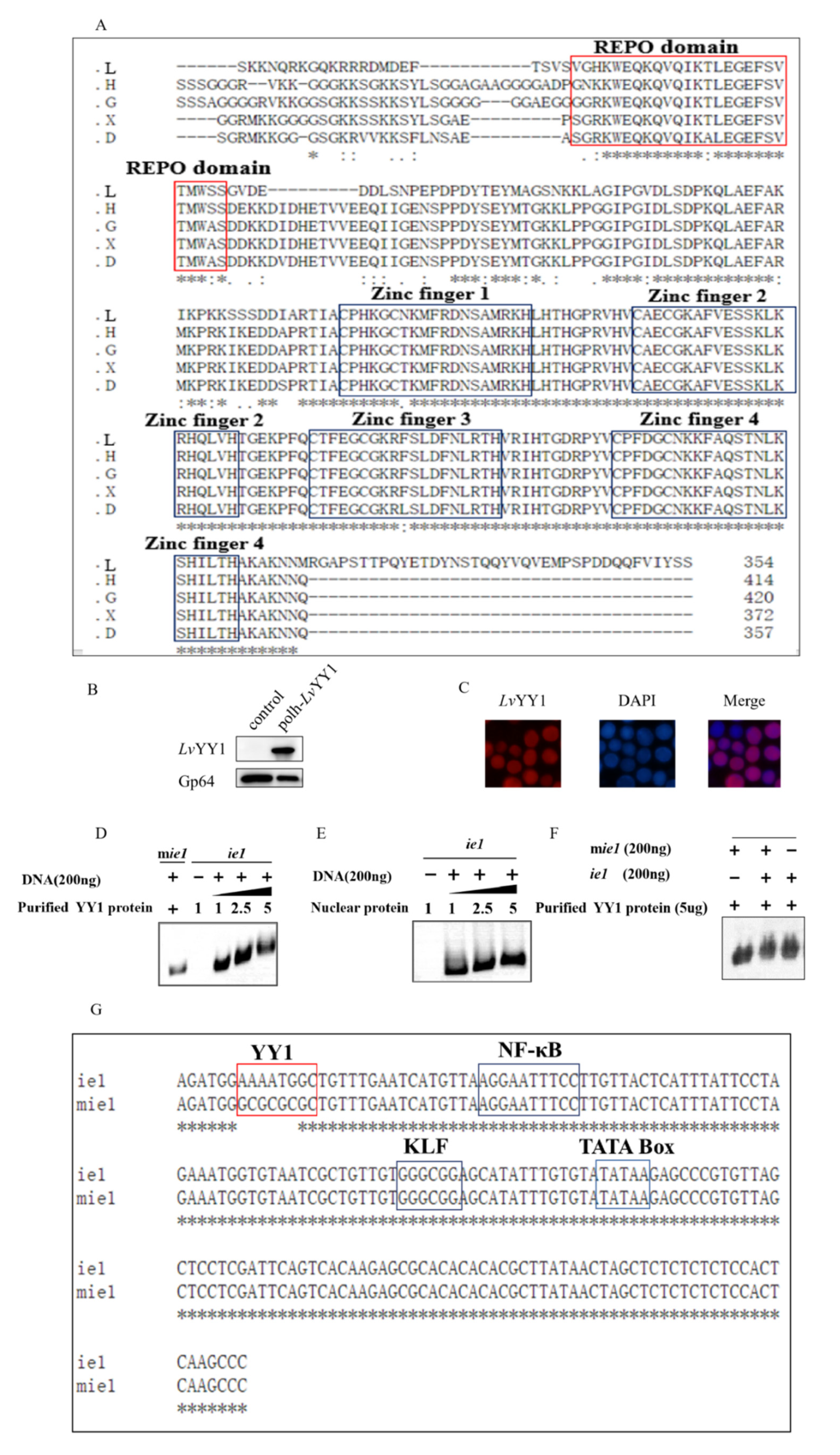
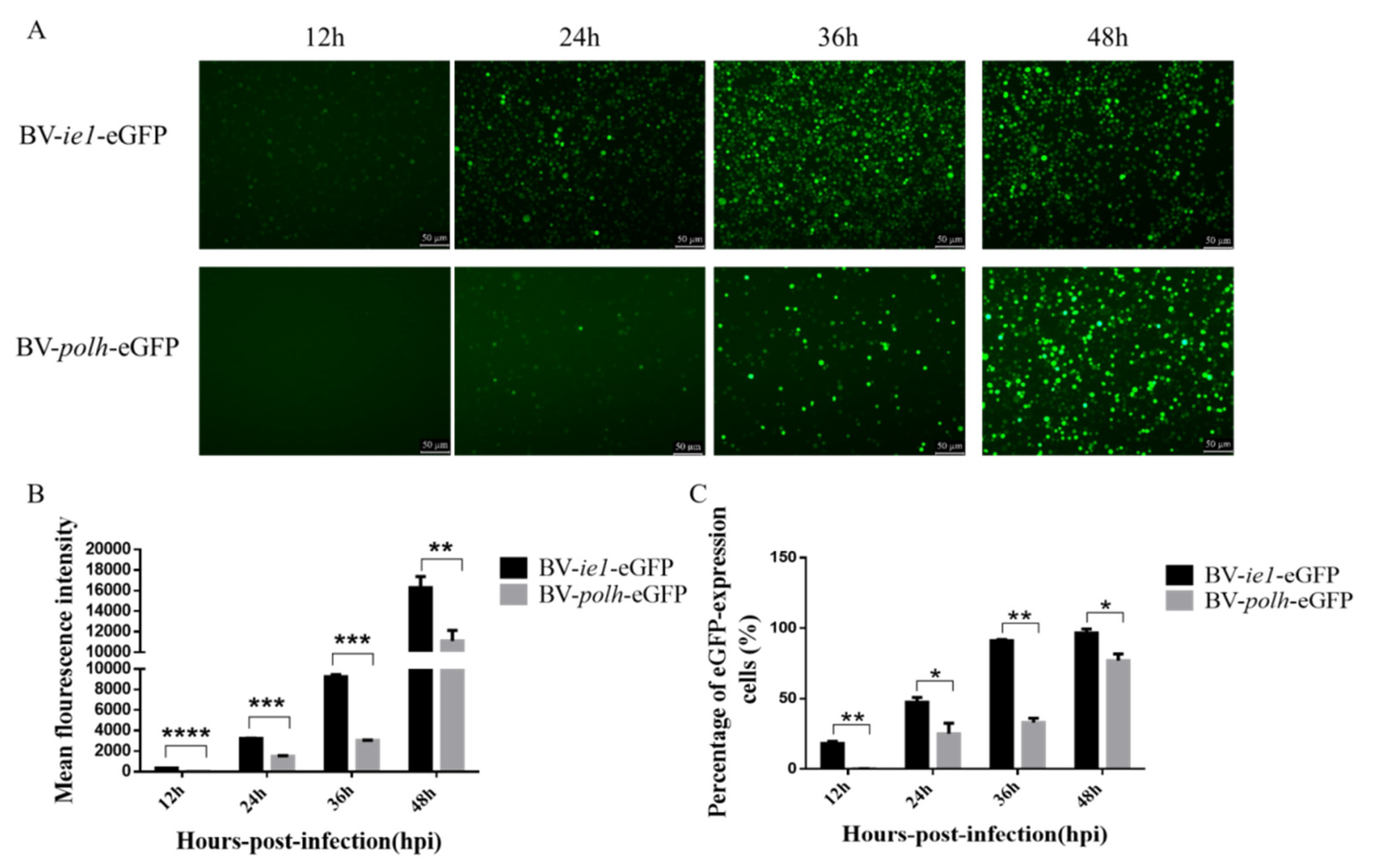
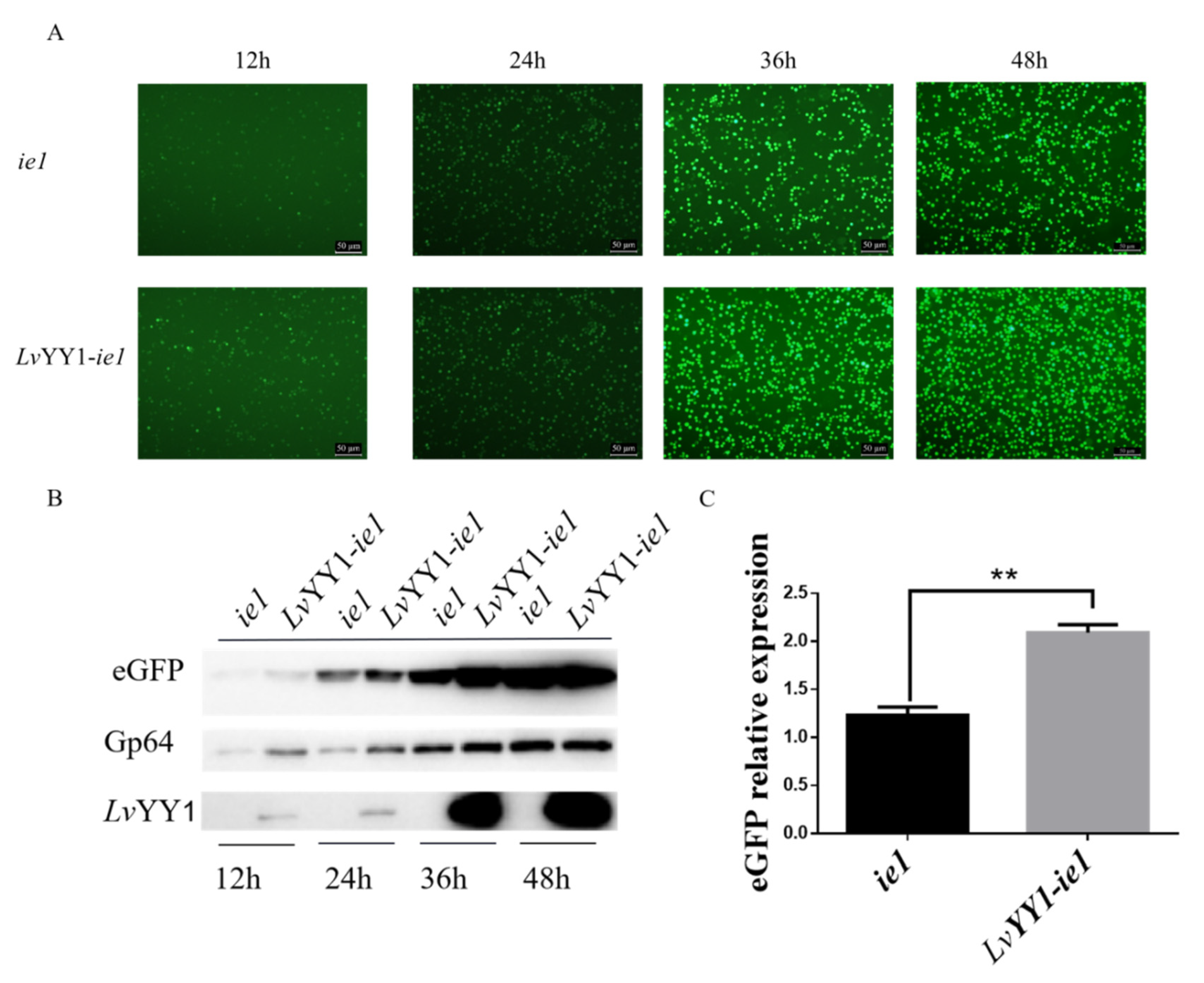
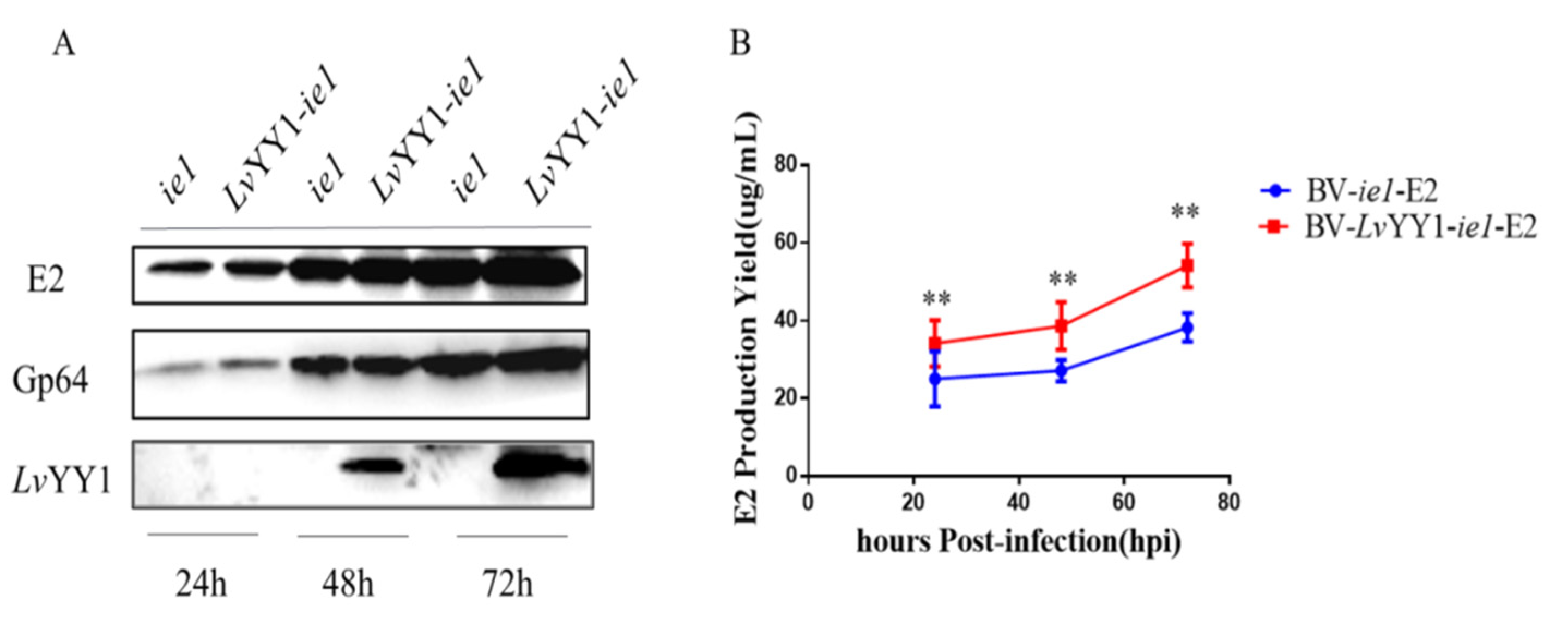
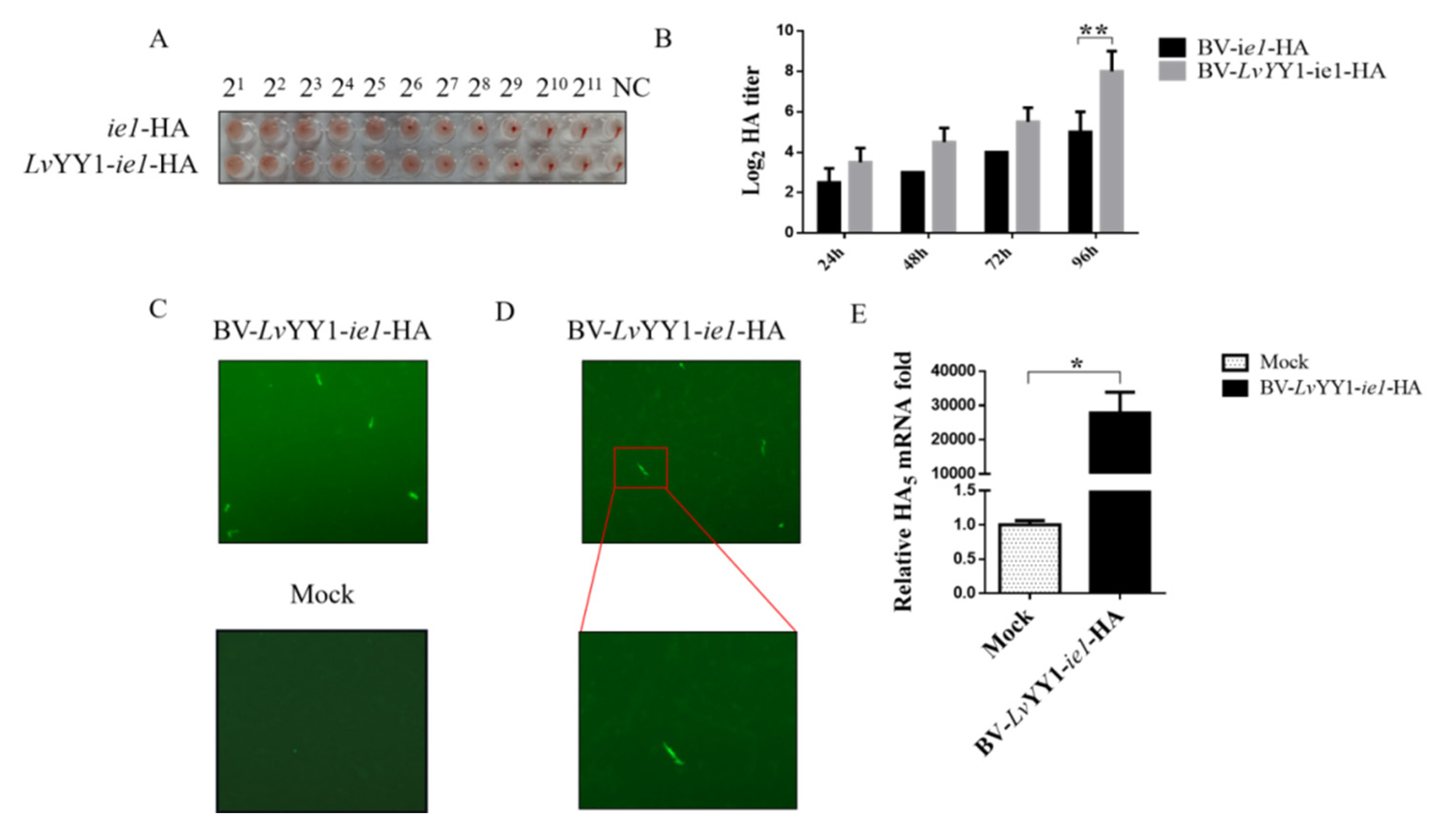
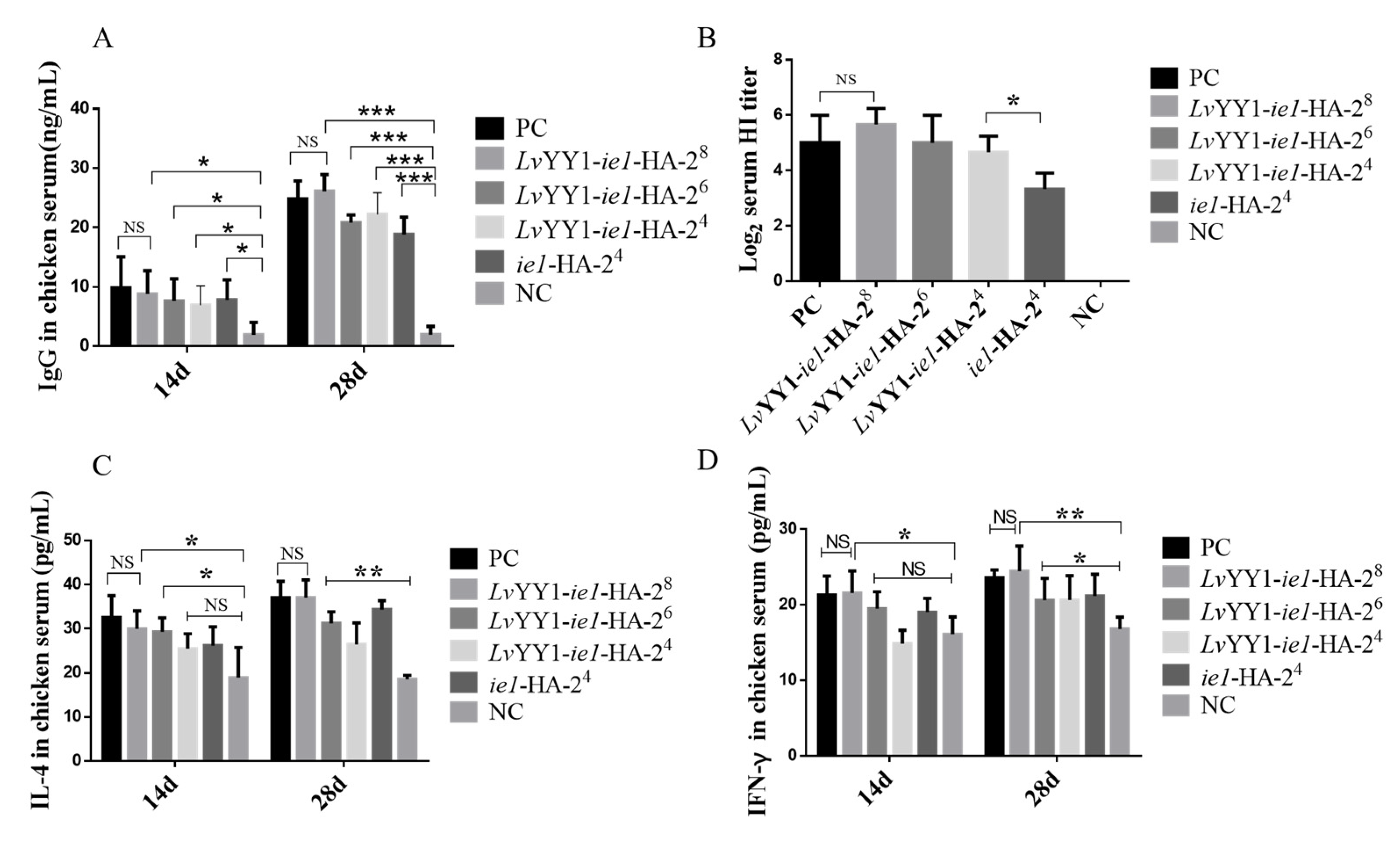
| Primer | Oligonucleotides (from 5′to 3′) | Product Size/bp |
|---|---|---|
| YY1-Flag-F | ATGGCCTCCTCCGACTTCGTGACCG | 1089 |
| YY1-Flag-R | TTACTTATCGTCGTCATCCTTGTAATCGGAGGAGTAGATCACGAATT | |
| ie1-F | ACGCGTTTGGCGTTTTATTTTCTTG | 518 |
| ie1-R | GGGCTTGAGTGGAGAGAGAGAGCTA | |
| eGFP-F | CTCTCTCTCCACTCAAGCCCATGGTGAGCAAGGGCGAGGAG | 720 |
| eGFP-R | TTACTTGTACAGCTCGTCCATGCCGAGA | |
| E2-F | ATGATAAAAGTATTAAGAGGGCAGG | 1068 |
| E2-R | CTACACGTCCAGGTCAAACCAGTAT | |
| HA-F | ATGGAGAAAATAGTGCTTCTTCTTGC | 1704 |
| HA-R | TTAAATGCAAATTCTGCATTGTAAC | |
| HA-F1 | GTCAAGAAAGGGGACTCAGCA | 181 |
| HA-R2 | GCCCAGTCGCAAGGACTAAT | |
| β-actin-F | GAG AAATTGTGCGTGACATCA | 152 |
| β-actin-R | CCTGAACCTCTCATTGCCA |
© 2020 by the authors. Licensee MDPI, Basel, Switzerland. This article is an open access article distributed under the terms and conditions of the Creative Commons Attribution (CC BY) license (http://creativecommons.org/licenses/by/4.0/).
Share and Cite
Tao, L.-N.; Liu, Z.-H.; Xu, H.-L.; Lu, Y.; Liao, M.; He, F. LvYY1 Activates WSSV ie1 Promoter for Enhanced Vaccine Production and Efficacy. Vaccines 2020, 8, 510. https://doi.org/10.3390/vaccines8030510
Tao L-N, Liu Z-H, Xu H-L, Lu Y, Liao M, He F. LvYY1 Activates WSSV ie1 Promoter for Enhanced Vaccine Production and Efficacy. Vaccines. 2020; 8(3):510. https://doi.org/10.3390/vaccines8030510
Chicago/Turabian StyleTao, Li-Na, Ze-Hui Liu, Hui-Ling Xu, Ying Lu, Min Liao, and Fang He. 2020. "LvYY1 Activates WSSV ie1 Promoter for Enhanced Vaccine Production and Efficacy" Vaccines 8, no. 3: 510. https://doi.org/10.3390/vaccines8030510
APA StyleTao, L.-N., Liu, Z.-H., Xu, H.-L., Lu, Y., Liao, M., & He, F. (2020). LvYY1 Activates WSSV ie1 Promoter for Enhanced Vaccine Production and Efficacy. Vaccines, 8(3), 510. https://doi.org/10.3390/vaccines8030510






